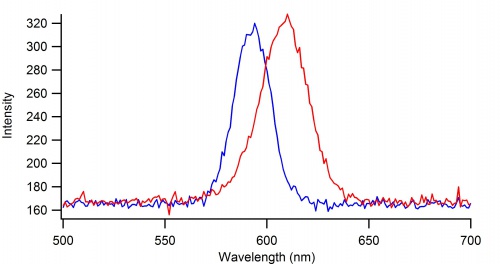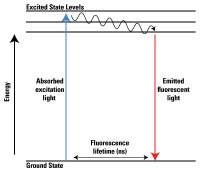Difference between revisions of "Submerge Christmas light in liquid nitrogen"
| (2 intermediate revisions by one other user not shown) | |||
| Line 1: | Line 1: | ||
| + | [[Light_lab_Pchem|Return to Light lab]] | ||
| + | |||
by Yejun Park (Chem 322, Spring 2017) | by Yejun Park (Chem 322, Spring 2017) | ||
| Line 8: | Line 10: | ||
| − | As it is shown in the youtube clip, dipping the Christmas lights changed the color of light. To ensure the change in color of light, we measured the wavelength of each color before and after dipping by using instrument called, Ocean Optics and Bed Tide USB650 UV. Graph below is the data that we got from this experiment. The wavelengths of two clearly showed that there was a color change due to change in temperature. Interestingly, the yellow light tended to go back to orange light as soon as it got warmer. | + | |
| + | [[File:Wavelength-nm.jpg|200px|thumb|right|alt text]]Change in color implies that there was a change in wavelength at the same time because visible colors have specific wavelengths. In this experiment, what we've seen was the orange light turned to yellow light. Meaning that there was a change in wavelegth; the wavelength shifted to the left or shorter wavelength. As it is shown in the youtube clip, dipping the Christmas lights changed the color of light. To ensure the change in color of light, we measured the wavelength of each color before and after dipping by using instrument called, Ocean Optics and Bed Tide USB650 UV. Graph below is the data that we got from this experiment. The wavelengths of two clearly showed that there was a color change due to change in temperature. Interestingly, the yellow light tended to go back to orange light as soon as it got warmer. | ||
[[File:Wavelength change.jpg|500px|thumb|center|Wavelength of Christmas lights before and after dipping it into liquid nitrogen; ''Data Collected by: Yejun Park and Samer Aljundi'']] | [[File:Wavelength change.jpg|500px|thumb|center|Wavelength of Christmas lights before and after dipping it into liquid nitrogen; ''Data Collected by: Yejun Park and Samer Aljundi'']] | ||
| − | |||
| − | |||
| − | |||
| − | |||
| Line 22: | Line 21: | ||
| − | Here is a link which might give you a better explanation, http:// | + | Here is a link which might give you a better explanation, http://www.physics-astronomy.com/2014/06/watch-led-light-change-color-in-liquid.html#.WIqLmlMrKUl |
| − | |||
If you still have doubt, take Inorganic class! | If you still have doubt, take Inorganic class! | ||
Latest revision as of 00:15, 27 January 2017
by Yejun Park (Chem 322, Spring 2017)
Wavelength of a light can be affected by temperature. To investigate this phenomenon, we decided to compare the wavelength of Christmas lights before and after putting them in liquid nitrogen.
Here is a youtube clip that shows exactly same thing that we did in lab.
https://youtu.be/4w1HifFayNU
Change in color implies that there was a change in wavelength at the same time because visible colors have specific wavelengths. In this experiment, what we've seen was the orange light turned to yellow light. Meaning that there was a change in wavelegth; the wavelength shifted to the left or shorter wavelength. As it is shown in the youtube clip, dipping the Christmas lights changed the color of light. To ensure the change in color of light, we measured the wavelength of each color before and after dipping by using instrument called, Ocean Optics and Bed Tide USB650 UV. Graph below is the data that we got from this experiment. The wavelengths of two clearly showed that there was a color change due to change in temperature. Interestingly, the yellow light tended to go back to orange light as soon as it got warmer.
If you have watched the youtube clip, you should have found out that the color of chirstmas light turned yellow from orange. This is because the coldness changed what is called thermal population of the Christmas lights. What it means is that by dipping the Christmas lights into liquid nitrogen, the electrons in each energy level dropped down to lower energy level. Now, the electrons cannot be excited to higher energy level what used to but lower energy level. Due to the difference in energy level, now, the fluorescence emit different color.
Here is a link which might give you a better explanation, http://www.physics-astronomy.com/2014/06/watch-led-light-change-color-in-liquid.html#.WIqLmlMrKUl
If you still have doubt, take Inorganic class!


